ExxonMobil Chemical
SpectraSyn Elite™ 65 joins ExxonMobil Chemical’s metallocene polyalphaolefin lineup
By Don Mattran, Technical Sales Representative, ExxonMobil Chemical | TLT CMF Plus November 2012
ExxonMobil Chemical’s Synthetics business dates back to the 1960s and has grown to be one of the world’s largest suppliers of synthetic fluids such as polyalphaolefins, alkylated naphthalenes and esters.
That growth continues today with the introduction of SpectraSyn Elite™ 65 metallocene polyalphaolefin (mPAO), which joins SpectraSyn Elite™ 150 as the next generation of PAO base stocks that can help lubricant formulators solve an ever-growing list of challenges.
These new products, in combination with investments like a new mPAO plant in Baytown, Texas, show ExxonMobil Chemical’s long-standing commitment to the lubricant industry.
Meeting today’s challenges
The innovative lubricant solutions that ExxonMobil Chem ical can enable with its advanced synthetic base stocks allow formulators to meet the needs of customers better than ever, tackling challenges that include:
•
more severe operating conditions, including extreme operating temperatures and loads,
•
longer drain interval requirements,
•
improved energy efficiency,
•
reduction in lubricating system volumes.
ExxonMobil Chemical base stocks feature high viscosity indexes, increased thermal and oxidative stability and enhanced low-temperature properties to ensure protection and performance in severe environments.
Key properties
ExxonMobil Chemical’s mPAO platform now has two viscosity grades, SpectraSyn Elite™ 150 and the newest addition, SpectraSyn Elite™ 65.
Figure 1 shows the key properties of these two products. Let’s focus on a few of these, such as the viscometrics, including VI; low-temperature properties, including pour point and Brookfield viscosity; and shear stability.
Product Properties
 Figure 1. Source: ExxonMobil Data
Proven performance
Figure 1. Source: ExxonMobil Data
Proven performance
When compared to a conventional 40 cSt PAO, SpectraSyn Elite™ 65 allows formulators to blend a wider range of viscosity grades, including ISO VG 460 and above; while the conventional 40 cSt PAO can only reach a viscosity meeting the ISO VG 320 requirements (
Figure 2). The shaded area above the conventional 40 cSt PAO represents the viscosities range that only can be reached using SpectraSyn Elite™ 65. A similar trend can be seen when comparing SpectraSyn Elite™ 150 to conventional 100 cSt PAO.
Enhanced Blending Flexibility
Viscosity Grade Coverage by Product
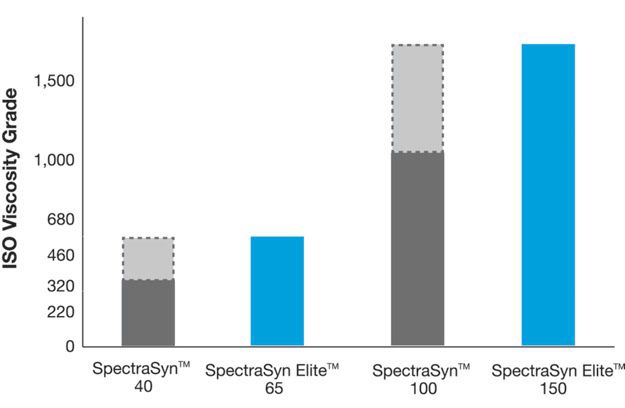 Figure 2. SpectraSyn Elite™ mPAOs provide the ability to blend to a wider viscosity range. Source: ExxonMobil Data
Figure 2. SpectraSyn Elite™ mPAOs provide the ability to blend to a wider viscosity range. Source: ExxonMobil Data
This is not only true when looking at base oil blends, but also with a wide range of applications, including industrial and automotive gear oils, where formulators are able to meet the viscometric and low-temperature properties of a 75W-140 gear oil.
Comparing individual properties of SpectraSyn Elite™ 65 to conventional base stocks, including PAOs, conventional PAOs typically have a viscosity index in the range of 140- 170. The viscosity index of polyiso-butylene (PIB) varies widely with viscosity, but overall, one thing remains constant: SpectraSyn Elite™mPAO has a higher VI than either conventional PAO or the commonly used PIB at equivalent viscosities (
Figure 3).
Viscosity Index Comparison
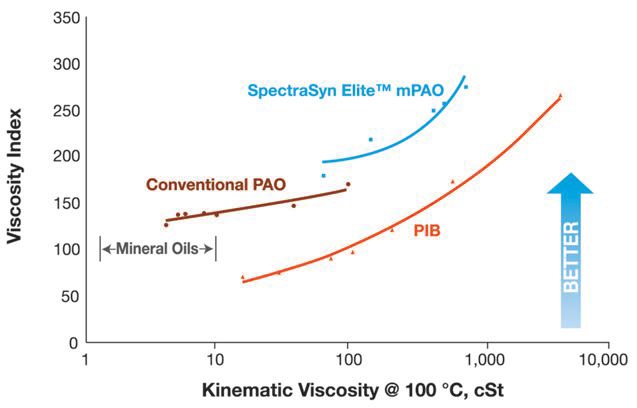 Figure 3. SpectraSyn Elite™ mPAOs demonstrate improved viscosity index. Test Method ASTM D 2270. Source: Reported by BP (re: PIB), published on the Indopol and Panalane Polybutene line (Aug. 2001); ExxonMobil Data
Figure 3. SpectraSyn Elite™ mPAOs demonstrate improved viscosity index. Test Method ASTM D 2270. Source: Reported by BP (re: PIB), published on the Indopol and Panalane Polybutene line (Aug. 2001); ExxonMobil Data
SpectraSyn Elite™ mPAO is 100 VI points higher than PIB and 40 VI points higher than high-viscosity PAO. This property of SpectraSyn Elite™ enables formulators to develop lubricants with better protection at high temperatures and improved fluidity at low temperatures, allowing for the protection needed and the potential for improved energy efficiency in many applications.
This increased viscosity index is also seen in fully formulated oils. In
Figure 4, an ISO VG 320 industrial gear oil is blended with either conventional 100 cSt PAO, SpectraSyn Elite™ 65 or SpectraSyn Elite™ 150. Both gear oils formulated with SpectraSyn Elite™ provide a substantial increase in VI, allowing formulators to achieve enhanced protection at high temperatures and improved low-temperature performance. This trend holds true for other grades of industrial oils. Spectra Syn Elite™ 65 also provides a boost in VI for automotive gear oils.
Viscosity Index Formulated Oils
Industrial Gear Oil – ISO VG 320
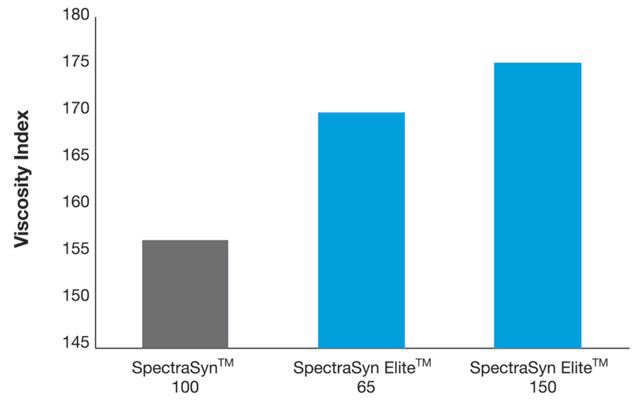 Figure 4. Industrial gear oils formulated with SpectraSyn Elite™mPAO demonstrate improved viscosity index. Test Method ASTM D 2270. Source: ExxonMobil Data
Improved pour points
Figure 4. Industrial gear oils formulated with SpectraSyn Elite™mPAO demonstrate improved viscosity index. Test Method ASTM D 2270. Source: ExxonMobil Data
Improved pour points
Low-temperature flow properties also benefit from SpectraSyn Elite™.
Figure 5 compares the pour points for PAO and PIB at various kinematic viscosities and shows that SpectraSyn Elite™ steps off the traditional pour point lines. At equivalent kinematic viscosities, SpectraSyn Elite™ metallocene PAO has a pour point about 20 degrees (Celsius) lower than PIB and several degrees lower than conventional PAO.
Pour Point Comparison
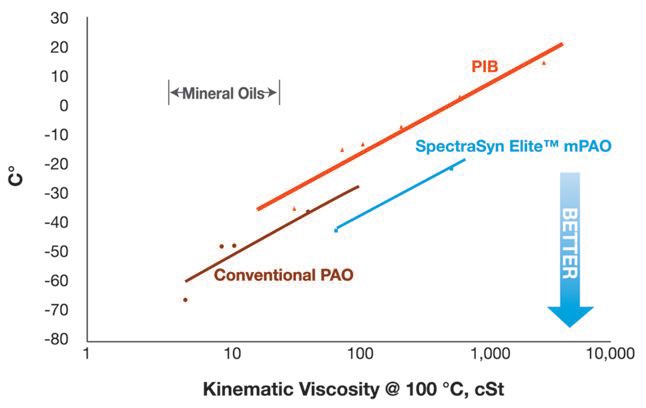 Figure 5. SpectraSyn Elite™ mPAOs have lower pour points. Test Method ASTM D 97/5950. Source: Reported by BP (re: PIB), published on the Indopol and Panalane Polybutene line (Aug. 2001); ExxonMobil Data
Figure 5. SpectraSyn Elite™ mPAOs have lower pour points. Test Method ASTM D 97/5950. Source: Reported by BP (re: PIB), published on the Indopol and Panalane Polybutene line (Aug. 2001); ExxonMobil Data
This advantage in pour point is also seen in fully formulated oils, specifically a 75W-90 gear oil. SpectraSyn Elite™ 65 provides a six-degree reduction in pour point when compared to an equivalent viscosity finished oil blended with conventional PAO. The same benefit is realized in 75W-140 gear oils as well as industrial oils formulated with SpectraSyn Elite™.
Another component of low-temperature performance is the measured Brookfield viscosity. SpectraSyn Elite™ 65 provides a significant benefit in this parameter (
Figure 6), even when its viscosity is higher than the conventional PAO used in the comparison. This allows formulators to blend a wider range of viscosity grade lubricants while still meeting the low-temperature specifications without using additional high-viscosity material.
Brookfield Comparison
Neat Base Stocks
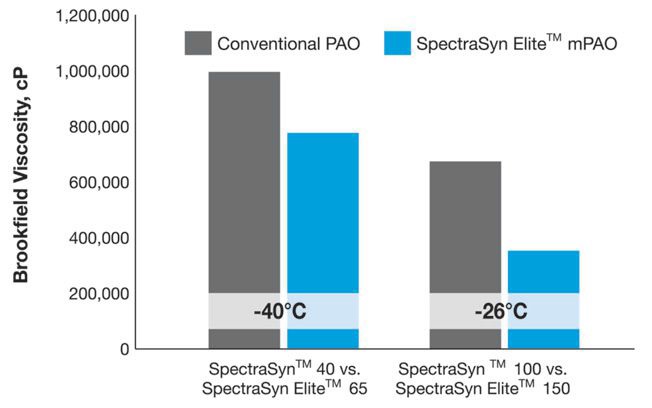 Figure 6. SpectraSyn Elite™mPAOs show exceptional Brookfield viscosity at low temperatures. Test Method ASTM D 2983. Source: ExxonMobil Data
Figure 6. SpectraSyn Elite™mPAOs show exceptional Brookfield viscosity at low temperatures. Test Method ASTM D 2983. Source: ExxonMobil Data
In order to show the significant advantages provided by SpectraSyn Elite™, two blends were made targeting a viscosity of 680 cSt at 40°C (
Figure 7). The first blend uses conventional PAO 40 and 100, with a viscosity of 678; while the second uses SpectraSyn Elite™ 65 and 150 products, resulting in a viscosity of 680. With the two viscosities being nearly equivalent, a direct comparison can be made that shows the Brookfield viscosity of the SpectraSyn Elite™ blends is essentially cut in half.
Brookfield Comparison
ISO VG 680 Base Oil Blend @-26°C
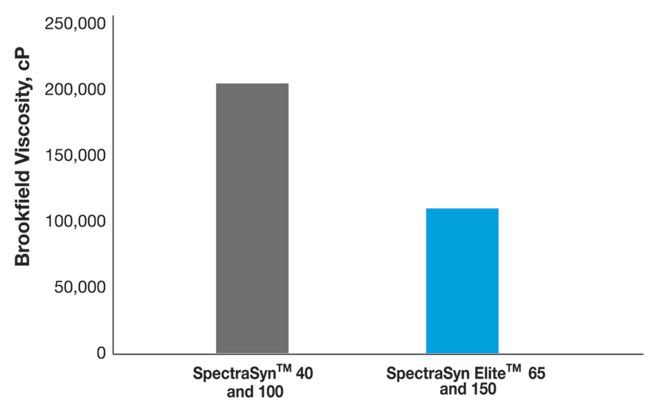 Figure 7. Oils blended with SpectraSyn Elite™mPAOs can significantly reduce the Brookfield viscosity in lubricant formulations. Test Method ASTM D 2983. Source: ExxonMobil Data
Figure 7. Oils blended with SpectraSyn Elite™mPAOs can significantly reduce the Brookfield viscosity in lubricant formulations. Test Method ASTM D 2983. Source: ExxonMobil Data
This advantage also translates into fully formulated industrial gear oils. When formulators replace conventional PAO with SpectraSyn Elite™ 65 or 150, they achieve a significant reduction in Brookfield viscosity in the finished lubricant, allowing for improved low-temperature properties and enhanced blending flexibility. When formulating a 75W-90 automotive gear oil, SpectraSyn Elite™ also allows the formulator to stay well below the required limits of OEM and industry specifications.
Summary
SpectraSyn Elite™ mPAO builds on more than two decades of ExxonMobil Chemical’s metallocene catalyst development and represents the latest addition to the largest and broadest synthetic base stock portfolio in the industry.
SpectraSyn Elite™ 65, in conjunction with SpectraSyn Elite™ 150, represents a new level of base stock performance, including:
•
an increased viscosity index that enables formulators to blend finished lubricants with increased protection at high temperatures and the required performance at low temperatures,
•
broader blending flexibility to provide formulators with more options when trying to optimize their formulation windows,
•
improved low-temperature properties, and
•
enhanced shear stability that lets formulators meet the shear requirements of the increasing severity of today’s applications.
Samples and commercial quantities of SpectraSyn Elite™ 65 and SpectraSyn Elite™ 150 are available worldwide.
Visit www.spectrasynelite.com for more information, including a downloadable information sheet and audio presentation.
©2012 ExxonMobil. ExxonMobil, the ExxonMobil logo, the interlocking “X” device and other product or service names used herein are trademarks of ExxonMobil, unless indicated otherwise. This document may not be distributed, displayed, copied or altered without ExxonMobil’s prior written authorization. To the extent ExxonMobil authorizes distributing, displaying and/or copying of this document, the user may do so only if the document is unaltered and complete, including all of its headers, footers, disclaimers and other information. You may not copy this document to or reproduce it in whole or in part on a website. ExxonMobil does not guarantee the typical (or other) values. Any data included herein is based upon analysis of representative samples and not the actual product shipped. The information in this document relates only to the named product or materials when not in combination with any other product or materials. We based the information on data believed to be reliable on the date compiled, but we do not represent, warrant, or otherwise guarantee, expressly or impliedly, the merchantability, fitness for a particular purpose, freedom from patent infringement, suitability, accuracy, reliability, or completeness of this information or the products, materials or processes described. The user is solely responsible for all determinations regarding any use of material or product and any process in its territories of interest. We expressly disclaim liability for any loss, damage or injury directly or indirectly suffered or incurred as a result of or related to anyone using or relying on any of the information in this document. This document is not an endorsement of any non-ExxonMobil product or process, and we expressly disclaim any contrary implication. The terms “we,” “our,” “ExxonMobil Chemical” and “ExxonMobil” are each used for convenience, and may include any one or more of ExxonMobil Chemical Company, Exxon Mobil Corporation, or any affiliate either directly or indirectly stewarded. SpectraSyn, SpectraSyn Elite, Synesstic and Esterex are trademarks of Exxon Mobil Corporation U.S.A.